2024年中考英语动词不定式总结课件(共24张PPT)
文档属性
| 名称 | 2024年中考英语动词不定式总结课件(共24张PPT) |  | |
| 格式 | pptx | ||
| 文件大小 | 9.8MB | ||
| 资源类型 | 教案 | ||
| 版本资源 | 通用版 | ||
| 科目 | 英语 | ||
| 更新时间 | 2024-05-08 21:05:06 | ||
图片预览


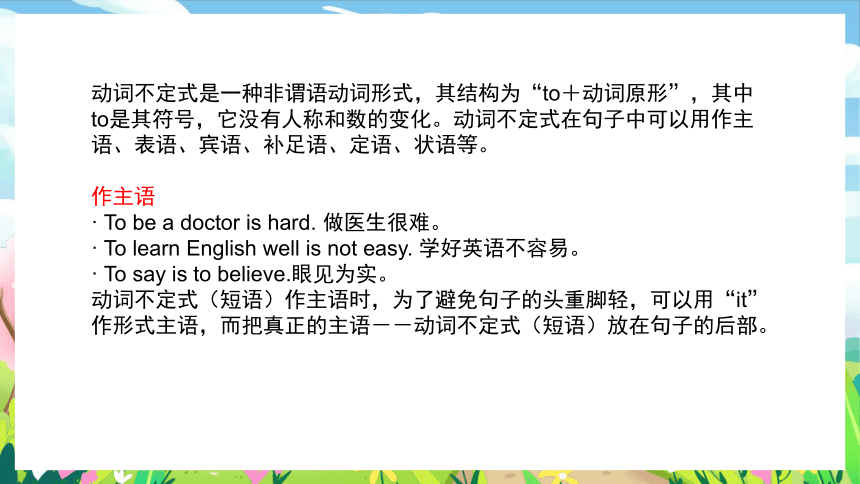
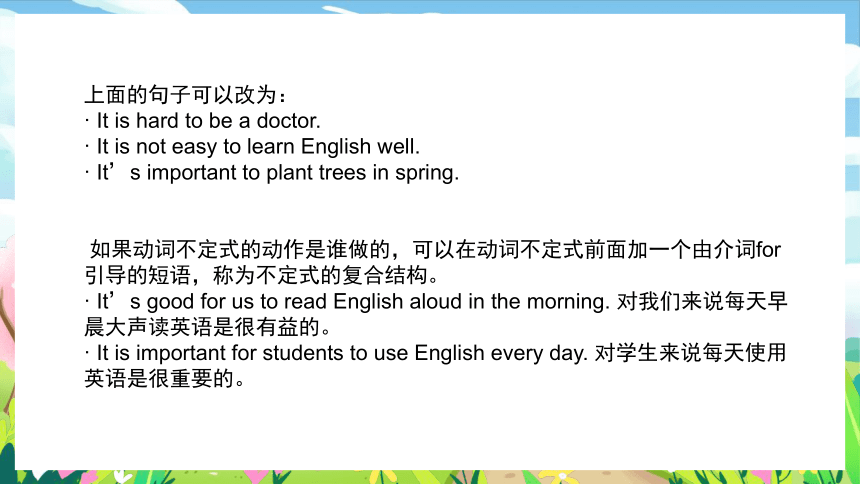
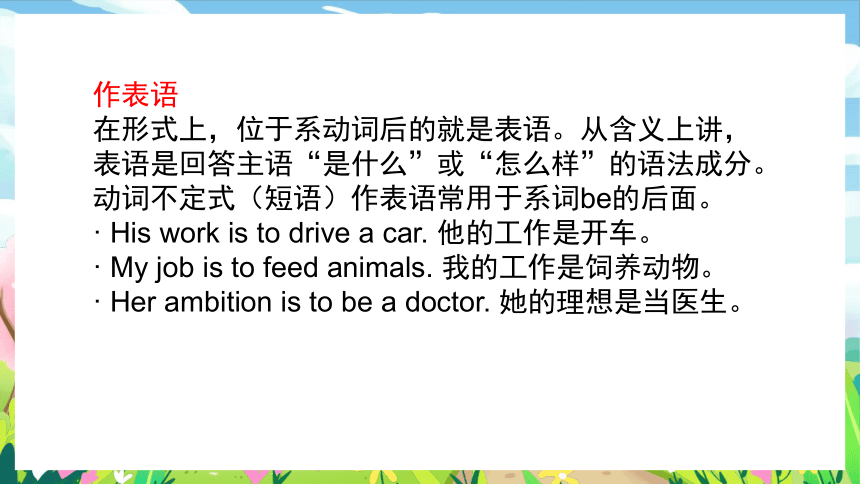
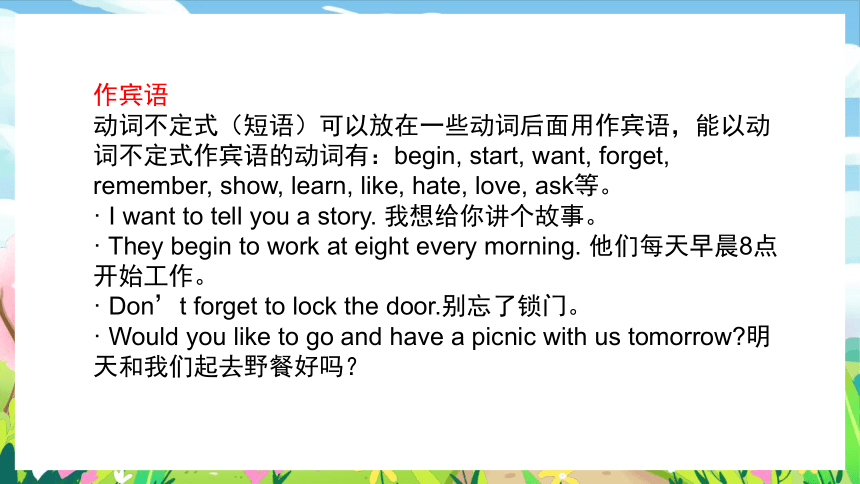
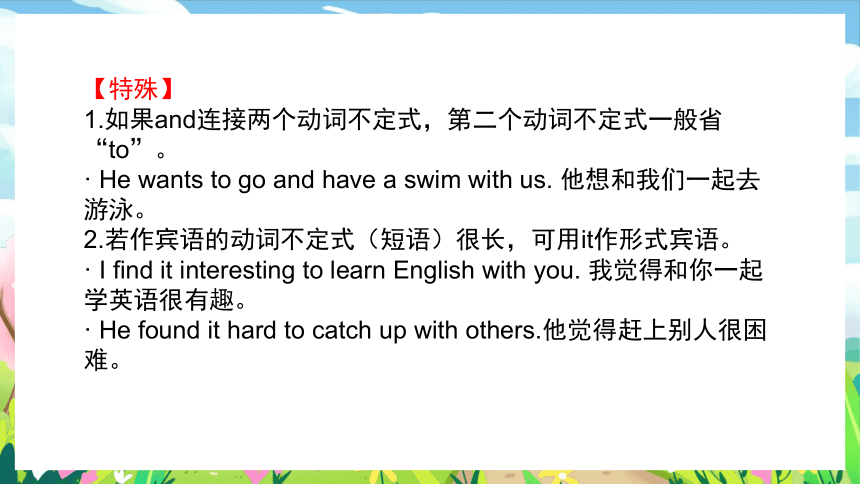
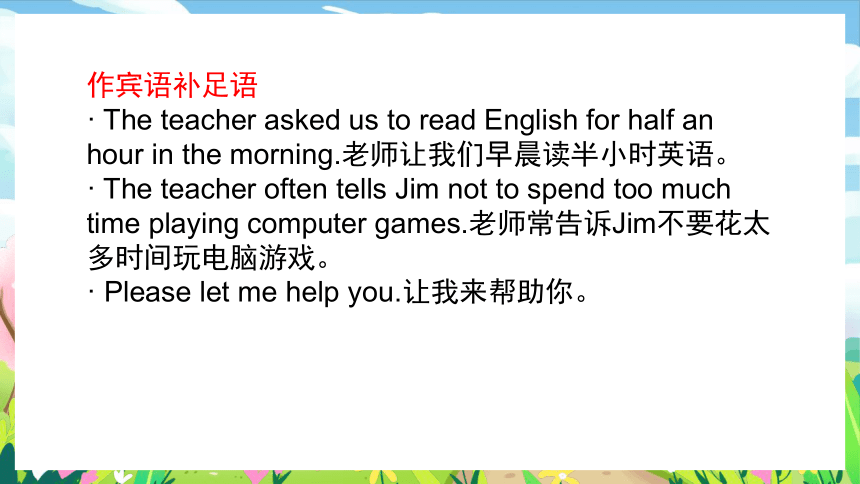
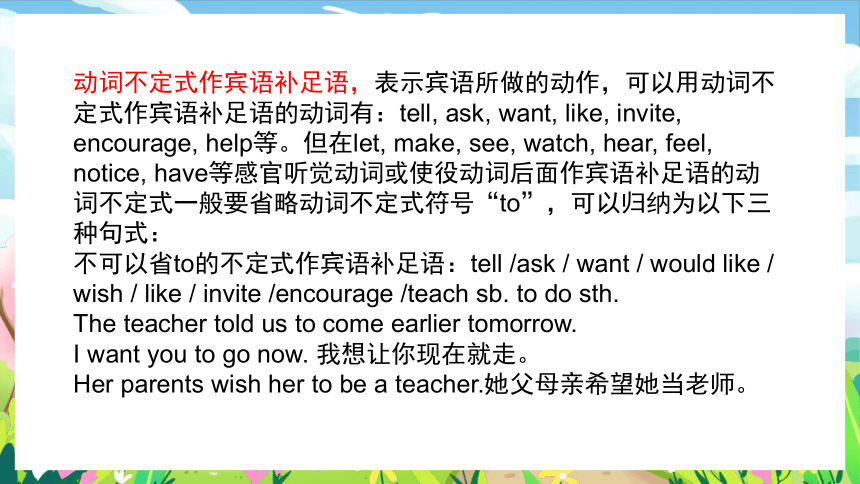
文档简介
(共24张PPT)
中考动词不定式总结
知识总结
1
动词不定式是一种非谓语动词形式,其结构为“to+动词原形”,其中to是其符号,它没有人称和数的变化。动词不定式在句子中可以用作主语、表语、宾语、补足语、定语、状语等。
作主语
· To be a doctor is hard. 做医生很难。
· To learn English well is not easy. 学好英语不容易。
· To say is to believe.眼见为实。
动词不定式(短语)作主语时,为了避免句子的头重脚轻,可以用“it”作形式主语,而把真正的主语--动词不定式(短语)放在句子的后部。
上面的句子可以改为:
· It is hard to be a doctor.
· It is not easy to learn English well.
· It’s important to plant trees in spring.
如果动词不定式的动作是谁做的,可以在动词不定式前面加一个由介词for引导的短语,称为不定式的复合结构。
· It’s good for us to read English aloud in the morning. 对我们来说每天早晨大声读英语是很有益的。
· It is important for students to use English every day. 对学生来说每天使用英语是很重要的。
作表语
在形式上,位于系动词后的就是表语。从含义上讲,表语是回答主语“是什么”或“怎么样”的语法成分。动词不定式(短语)作表语常用于系词be的后面。
· His work is to drive a car. 他的工作是开车。
· My job is to feed animals. 我的工作是饲养动物。
· Her ambition is to be a doctor. 她的理想是当医生。
作宾语
动词不定式(短语)可以放在一些动词后面用作宾语,能以动词不定式作宾语的动词有:begin, start, want, forget, remember, show, learn, like, hate, love, ask等。
· I want to tell you a story. 我想给你讲个故事。
· They begin to work at eight every morning. 他们每天早晨8点开始工作。
· Don’t forget to lock the door.别忘了锁门。
· Would you like to go and have a picnic with us tomorrow 明天和我们起去野餐好吗?
【特殊】
1.如果and连接两个动词不定式,第二个动词不定式一般省“to”。
· He wants to go and have a swim with us. 他想和我们一起去游泳。
2.若作宾语的动词不定式(短语)很长,可用it作形式宾语。
· I find it interesting to learn English with you. 我觉得和你一起学英语很有趣。
· He found it hard to catch up with others.他觉得赶上别人很困难。
作宾语补足语
· The teacher asked us to read English for half an hour in the morning.老师让我们早晨读半小时英语。
· The teacher often tells Jim not to spend too much time playing computer games.老师常告诉Jim不要花太多时间玩电脑游戏。
· Please let me help you.让我来帮助你。
动词不定式作宾语补足语,表示宾语所做的动作,可以用动词不定式作宾语补足语的动词有:tell, ask, want, like, invite, encourage, help等。但在let, make, see, watch, hear, feel, notice, have等感官听觉动词或使役动词后面作宾语补足语的动词不定式一般要省略动词不定式符号“to”,可以归纳为以下三种句式:
不可以省to的不定式作宾语补足语:tell /ask / want / would like / wish / like / invite /encourage /teach sb. to do sth.
The teacher told us to come earlier tomorrow.
I want you to go now. 我想让你现在就走。
Her parents wish her to be a teacher.她父母亲希望她当老师。
省“to”的不定式作宾语补足语:Let / make / have sb. do sth.
Let the boy go out now. 让那个男孩出去。
The boy made the baby cry. 男孩弄哭了这个小孩。
see / watch / hear / notice / feel sb. do sth.
I saw the students play basketball on the playground yesterday.昨天我看见学生们在操场打篮球。
I often hear the girl sing in the next room. 我经常听到女孩在隔壁唱歌。
可省可不省的:help sb. (to)do sth.
I often help my mother (to)do housework. 我经常帮妈妈做家务。
(1)动词不定式的否定式是直接在to之前加not。
· Tell them not to play football in the street.告诉他们不要在街道上踢足球。
(2)省to的动词不定式的否定式是直接在动词前面加not。
· Let the boy not go. 让那个男孩别走。
(3)如果将主动语态变为被动语态时,作宾语补足语的动词不定式变为主语补足语,动词不定式则不省“to”,即原来省的再加上。
· The boy made the baby cry.
· The baby was made to cry by the boy.那个孩子被男孩弄哭了。
作定语
动词不定式作定语常用来修饰名词或不定代词,放于所修饰的词后,为后置定语。
· Who was the first one to arrive 谁第一个到的?
· She has no paper to write on 她没有纸写字?
· The best way to learn English is to use it. 学英语最好的方法是使用它。
· When is the best time to plant vegetables 什么时候是种植蔬菜的最好时间?· Do you have something to drink 你这有喝的吗?
动词不定式(短语)作定语修饰名词时,与其所修饰的词具有一种动宾关系,如果不定式中的动词为不及物动词时,其后应加上一个含义上所需要的介词。
· I have no chair to sit on.我没有椅子坐。
· He has no house to live in.他没有房子住。
作目的状语
动词不定式作目的状语常用在go, come, hurry等不及物动词后,表目的。
· He went to see his sister yesterday.他昨天去看妹妹了。
· They got up early to catch the early bus.他们早起去赶早班车。
有时可以把不定式(短语)提前,放于句首,表示强调目的。
· To learn English quickly and well, he went to England.为了更快更好地学英语,他去了英国。
真题实例
2
(一)用所给动词的正确形式填空
1. She said she offered ____ (take) me to the shopping center.
2. They decided ____ (play) tennis against Guangming Middle School.
3. He wanted _____ (watch) the football match at the stadium.
4. My parents plan _____ (visit) my grandparents next weekend.
5. David promised ____ (not be)late for school next time.
(二)根据短文内容,用所给动词的正确形式填空。
A
he radio says it will be sunny this weekend. Diana plans 1.____ (enjoy) the sun on the beach. She wants 2._____ (invite) Lucy to go with her. But Lucy said her parents offered 3._____ (take) her to the cinema. So Lucy wouldn't like 4._____ (go) with Diana. Finally Diana decided 5.______ (go) to the beach alone.
B
Lu Xun is one of the greatest writers of modern China. He was born in Shaoxing, Zhejiang Province, in 1881. At first, Lu Xun hoped 6._____ (help) the Chinese people become healthy and strong, so he decided 7.______ (be) a doctor. After a few years, he started 8.______ (write) short stories because he wanted 9._____ (teach) people about society. One of his most famous stories is The True Story of Ah Q. It describes the hard life of Ah Q and makes people think about society. In the 1920s, people began10. _____ (translate翻译) his work into English.
(三)单项选择
1. I can't tell you what she said. I've promised ____ it a secret.
A. keep B. to keep C. keeping D. kept
2. -- What's your plan for the summer holiday
-- I decide ____ at home and have a good rest fist.
A. to stay B. staying C. stayed D. stay
3. I was waiting ____ across the road when a car hit a boy suddenly.
A. walk B. walking C. to walk D. walks
4. My parents agree _____ football with my classmates on Sunday afternoon.
A. plays B. to play C. playing D. played
5. -- Dad, Can I borrow your camera I want ____ it to take some photos.
-- Sure. But you must promise _____ after it well.
A. to use; look B. use; to look C. to use; to look D. use; look
翻译下列句子。体会不定式做目的状语的功能。
1. To make it easier for the tigers to live, we should protect their home in the wild.
2. We should work hard to stop people killing tigers.
3. Let's find out what else we can do to save as many animals as possible.
4. They do important research to find out the best way to protect animals.
5. They also develop plans to help animals in danger.
用所给词的正确形式填空
1. Their parents don't allow them ____(swim) in the river. It's really dangerous.
2. Please tell the boys _____ (not make) any noise. My baby is sleeping.
3. They try to find some more ways to make some animals ____ (work) for people.
4. My friend invited me ____ (watch) Beijing Opera last weekend.
5. I often hear a girl _____ (practise) playing the piano in the classroom.
(一)用所给动词的正确形式填空
1. to take 依据:offer to do 主动提出做某事
2. to play 依据:decide to do 决定做某事
3. to watch 依据:want to do 想要做某事
4. to visit 依据:plan to do 计划做某事
5. not to be 依据:promise to do 答应做某事,保证做某事
(二)根据短文内容,用所给动词的正确形式填空。
A
1. to enjoy, 2. to invite, 3.to take, 4. to go(解析:would like to do想要做某事), 5. to go
B
6. to help(解析:依据want to do 想要做某事), 7. to be(解析:依据decide to do决定做某事), 8. to write(解析:依据start to do 开始做某事), 9. to teach(解析:依据want to do想要做某事),
10. to translate(解析:依据begin to do 开始做某事)
(三)单项选择
1. B 依据:promise to do 答应做某事
2. A 依据:decide to do决定做某事
3. C 依据:wait to do 等待做某事
4. B 依据:agree to do 同意做某事
5. C 依据: want to do 想要做某事,promise to do 答应做某事
翻译下列句子。体会不定式做目的状语的功能。
1. 为了让老虎更容易地生存, 我们应该保护它们在野外的家。
2. 我们应该努力工作来阻止人们猎杀老虎。
3. 让我们弄清楚我们还能做什么来拯救尽可能多的动物。
4. 他们做重要的研究为的是找出保护动物的最佳方法。
5.他们也制定计划来保护濒危动物。
(一)用所给词的正确形式填空
1. to swim依据:allow sb. to do 允许某人做某事。
2. not to make 依据:tell sb. not to do 告诉某人不要做某事。
3. work 依据:make sb. do 使某人做某事
4. to watch 依据:invite sb. to do 邀请某人做某事
5. practice 依据:hear sb. do 听见某人做某事,指听到的是动作的全过程。
Thanks
中考动词不定式总结
知识总结
1
动词不定式是一种非谓语动词形式,其结构为“to+动词原形”,其中to是其符号,它没有人称和数的变化。动词不定式在句子中可以用作主语、表语、宾语、补足语、定语、状语等。
作主语
· To be a doctor is hard. 做医生很难。
· To learn English well is not easy. 学好英语不容易。
· To say is to believe.眼见为实。
动词不定式(短语)作主语时,为了避免句子的头重脚轻,可以用“it”作形式主语,而把真正的主语--动词不定式(短语)放在句子的后部。
上面的句子可以改为:
· It is hard to be a doctor.
· It is not easy to learn English well.
· It’s important to plant trees in spring.
如果动词不定式的动作是谁做的,可以在动词不定式前面加一个由介词for引导的短语,称为不定式的复合结构。
· It’s good for us to read English aloud in the morning. 对我们来说每天早晨大声读英语是很有益的。
· It is important for students to use English every day. 对学生来说每天使用英语是很重要的。
作表语
在形式上,位于系动词后的就是表语。从含义上讲,表语是回答主语“是什么”或“怎么样”的语法成分。动词不定式(短语)作表语常用于系词be的后面。
· His work is to drive a car. 他的工作是开车。
· My job is to feed animals. 我的工作是饲养动物。
· Her ambition is to be a doctor. 她的理想是当医生。
作宾语
动词不定式(短语)可以放在一些动词后面用作宾语,能以动词不定式作宾语的动词有:begin, start, want, forget, remember, show, learn, like, hate, love, ask等。
· I want to tell you a story. 我想给你讲个故事。
· They begin to work at eight every morning. 他们每天早晨8点开始工作。
· Don’t forget to lock the door.别忘了锁门。
· Would you like to go and have a picnic with us tomorrow 明天和我们起去野餐好吗?
【特殊】
1.如果and连接两个动词不定式,第二个动词不定式一般省“to”。
· He wants to go and have a swim with us. 他想和我们一起去游泳。
2.若作宾语的动词不定式(短语)很长,可用it作形式宾语。
· I find it interesting to learn English with you. 我觉得和你一起学英语很有趣。
· He found it hard to catch up with others.他觉得赶上别人很困难。
作宾语补足语
· The teacher asked us to read English for half an hour in the morning.老师让我们早晨读半小时英语。
· The teacher often tells Jim not to spend too much time playing computer games.老师常告诉Jim不要花太多时间玩电脑游戏。
· Please let me help you.让我来帮助你。
动词不定式作宾语补足语,表示宾语所做的动作,可以用动词不定式作宾语补足语的动词有:tell, ask, want, like, invite, encourage, help等。但在let, make, see, watch, hear, feel, notice, have等感官听觉动词或使役动词后面作宾语补足语的动词不定式一般要省略动词不定式符号“to”,可以归纳为以下三种句式:
不可以省to的不定式作宾语补足语:tell /ask / want / would like / wish / like / invite /encourage /teach sb. to do sth.
The teacher told us to come earlier tomorrow.
I want you to go now. 我想让你现在就走。
Her parents wish her to be a teacher.她父母亲希望她当老师。
省“to”的不定式作宾语补足语:Let / make / have sb. do sth.
Let the boy go out now. 让那个男孩出去。
The boy made the baby cry. 男孩弄哭了这个小孩。
see / watch / hear / notice / feel sb. do sth.
I saw the students play basketball on the playground yesterday.昨天我看见学生们在操场打篮球。
I often hear the girl sing in the next room. 我经常听到女孩在隔壁唱歌。
可省可不省的:help sb. (to)do sth.
I often help my mother (to)do housework. 我经常帮妈妈做家务。
(1)动词不定式的否定式是直接在to之前加not。
· Tell them not to play football in the street.告诉他们不要在街道上踢足球。
(2)省to的动词不定式的否定式是直接在动词前面加not。
· Let the boy not go. 让那个男孩别走。
(3)如果将主动语态变为被动语态时,作宾语补足语的动词不定式变为主语补足语,动词不定式则不省“to”,即原来省的再加上。
· The boy made the baby cry.
· The baby was made to cry by the boy.那个孩子被男孩弄哭了。
作定语
动词不定式作定语常用来修饰名词或不定代词,放于所修饰的词后,为后置定语。
· Who was the first one to arrive 谁第一个到的?
· She has no paper to write on 她没有纸写字?
· The best way to learn English is to use it. 学英语最好的方法是使用它。
· When is the best time to plant vegetables 什么时候是种植蔬菜的最好时间?· Do you have something to drink 你这有喝的吗?
动词不定式(短语)作定语修饰名词时,与其所修饰的词具有一种动宾关系,如果不定式中的动词为不及物动词时,其后应加上一个含义上所需要的介词。
· I have no chair to sit on.我没有椅子坐。
· He has no house to live in.他没有房子住。
作目的状语
动词不定式作目的状语常用在go, come, hurry等不及物动词后,表目的。
· He went to see his sister yesterday.他昨天去看妹妹了。
· They got up early to catch the early bus.他们早起去赶早班车。
有时可以把不定式(短语)提前,放于句首,表示强调目的。
· To learn English quickly and well, he went to England.为了更快更好地学英语,他去了英国。
真题实例
2
(一)用所给动词的正确形式填空
1. She said she offered ____ (take) me to the shopping center.
2. They decided ____ (play) tennis against Guangming Middle School.
3. He wanted _____ (watch) the football match at the stadium.
4. My parents plan _____ (visit) my grandparents next weekend.
5. David promised ____ (not be)late for school next time.
(二)根据短文内容,用所给动词的正确形式填空。
A
he radio says it will be sunny this weekend. Diana plans 1.____ (enjoy) the sun on the beach. She wants 2._____ (invite) Lucy to go with her. But Lucy said her parents offered 3._____ (take) her to the cinema. So Lucy wouldn't like 4._____ (go) with Diana. Finally Diana decided 5.______ (go) to the beach alone.
B
Lu Xun is one of the greatest writers of modern China. He was born in Shaoxing, Zhejiang Province, in 1881. At first, Lu Xun hoped 6._____ (help) the Chinese people become healthy and strong, so he decided 7.______ (be) a doctor. After a few years, he started 8.______ (write) short stories because he wanted 9._____ (teach) people about society. One of his most famous stories is The True Story of Ah Q. It describes the hard life of Ah Q and makes people think about society. In the 1920s, people began10. _____ (translate翻译) his work into English.
(三)单项选择
1. I can't tell you what she said. I've promised ____ it a secret.
A. keep B. to keep C. keeping D. kept
2. -- What's your plan for the summer holiday
-- I decide ____ at home and have a good rest fist.
A. to stay B. staying C. stayed D. stay
3. I was waiting ____ across the road when a car hit a boy suddenly.
A. walk B. walking C. to walk D. walks
4. My parents agree _____ football with my classmates on Sunday afternoon.
A. plays B. to play C. playing D. played
5. -- Dad, Can I borrow your camera I want ____ it to take some photos.
-- Sure. But you must promise _____ after it well.
A. to use; look B. use; to look C. to use; to look D. use; look
翻译下列句子。体会不定式做目的状语的功能。
1. To make it easier for the tigers to live, we should protect their home in the wild.
2. We should work hard to stop people killing tigers.
3. Let's find out what else we can do to save as many animals as possible.
4. They do important research to find out the best way to protect animals.
5. They also develop plans to help animals in danger.
用所给词的正确形式填空
1. Their parents don't allow them ____(swim) in the river. It's really dangerous.
2. Please tell the boys _____ (not make) any noise. My baby is sleeping.
3. They try to find some more ways to make some animals ____ (work) for people.
4. My friend invited me ____ (watch) Beijing Opera last weekend.
5. I often hear a girl _____ (practise) playing the piano in the classroom.
(一)用所给动词的正确形式填空
1. to take 依据:offer to do 主动提出做某事
2. to play 依据:decide to do 决定做某事
3. to watch 依据:want to do 想要做某事
4. to visit 依据:plan to do 计划做某事
5. not to be 依据:promise to do 答应做某事,保证做某事
(二)根据短文内容,用所给动词的正确形式填空。
A
1. to enjoy, 2. to invite, 3.to take, 4. to go(解析:would like to do想要做某事), 5. to go
B
6. to help(解析:依据want to do 想要做某事), 7. to be(解析:依据decide to do决定做某事), 8. to write(解析:依据start to do 开始做某事), 9. to teach(解析:依据want to do想要做某事),
10. to translate(解析:依据begin to do 开始做某事)
(三)单项选择
1. B 依据:promise to do 答应做某事
2. A 依据:decide to do决定做某事
3. C 依据:wait to do 等待做某事
4. B 依据:agree to do 同意做某事
5. C 依据: want to do 想要做某事,promise to do 答应做某事
翻译下列句子。体会不定式做目的状语的功能。
1. 为了让老虎更容易地生存, 我们应该保护它们在野外的家。
2. 我们应该努力工作来阻止人们猎杀老虎。
3. 让我们弄清楚我们还能做什么来拯救尽可能多的动物。
4. 他们做重要的研究为的是找出保护动物的最佳方法。
5.他们也制定计划来保护濒危动物。
(一)用所给词的正确形式填空
1. to swim依据:allow sb. to do 允许某人做某事。
2. not to make 依据:tell sb. not to do 告诉某人不要做某事。
3. work 依据:make sb. do 使某人做某事
4. to watch 依据:invite sb. to do 邀请某人做某事
5. practice 依据:hear sb. do 听见某人做某事,指听到的是动作的全过程。
Thanks
同课章节目录
- 词法
- 名词
- 动词和动词短语
- 动词语态
- 动词时态
- 助动词和情态动词
- 非谓语动词
- 冠词
- 代词
- 数词和量词
- 形容词副词及其比较等级
- 介词和介词短语
- 连词和感叹词
- 构词法
- 相似、相近词比较
- 句法
- 陈述句
- 一般疑问句和否定疑问句
- 特殊疑问句及选择疑问句
- 反意疑问句
- 存在句(There be句型)
- 宾语从句
- 定语从句
- 状语从句
- 主谓一致问题
- 简单句
- 并列句
- 复合句
- 主谓一致
- 主、表语从句
- 名词性从句
- 直接引语和间接引语
- 虚拟语气
- 感叹句
- 强调句
- 倒装句
- 祈使句
- 句子的成分
- 句子的分类
- 题型专区
- 单项选择部分
- 易错题
- 完形填空
- 阅读理解
- 词汇练习
- 听说训练
- 句型转换
- 补全对话
- 短文改错
- 翻译
- 书面表达
- 任务型阅读
- 语法填空
- 其他资料
